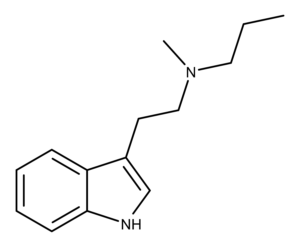The Chemistry of MPT
MPT is a synthetic tryptamine that is a structural analog of the psychedelic drug DMT (N,N-dimethyltryptamine). Manske published the first synthesis of DMT in 1931.1 However, since that time, its analog MTP has not received any significant research attention. The first mention of MPT in the scientific literature appears to be in a 2005 tryptamine synthesis paper by Brandt et al.2
Alexander and Ann Shulgin described their synthesis of MPT in TiHKAL:3 “This was made via the amide from indoleglyoxyl chloride and methylpropylamine, and reduction with LAH [lithium aluminum hydride].”
In response to the increasing interest in psychedelic drug therapy, Chadeayne et al. solved the crystal structure of MPT in 2019.4 This crystal structure gives drug researchers another option for exploration in developing psychedelic drug formulations. Before this paper, Chadeayne et al. had published the crystal structures of two other compounds, 4-AcO-DMT fumarate5 and psilacetin.6
The Pharmacology of MPT
No research has been conducted on the pharmacology of MPT.
In TiHKAL, the Shulgin’s briefly discuss MPT in compound #47, MiPT (N-methyl-N-isopropyltryptamine). In several self-testing trials, the Shulgin’s experienced no effects from MPT at oral doses up to 20 mg. They compared this lack of effect to that of its psychoactive analog MiPT. They theorized that “the lumpiness of the isopropyl [in MiPT] may be playing some role.”
The Applications and Potential of MPT
The lifting stigma surrounding psychedelics is opening the way for many discoveries that can improve people’s lives. Unlike more well-known psychedelic compounds such as psilocin, DMT, and MiPT, MPT is an understudied compound. Because of its structural similarities to DMT, MPT may offer possibilities for psychedelic drug development. The crystal structure solved by Chadeayne et al. is the first step in this research path.
